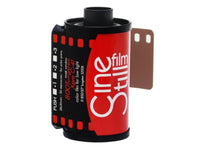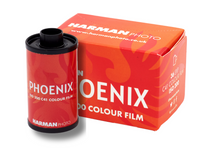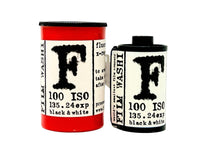Black Friday 2025 has landed at Analogue Wonderland, bringing some of our biggest film photography deals of the year - from discounted film and cameras to money-saving WonderLab processing offers, exclusive bundles, and festive specials available for a limited time only. Grab a great deal while stocks last!
Recent posts
Shop the article

Halation on Film: the Enchanting Glow of Analogue Photography
By Paul McKay
In a world hurtling ever-faster towards digital dominance, there's something enchanting about stepping back and embracing the beauty of analogue photography. Halation, a photographic effect weaving a soft glow and a romantic, dreamlike quality, has charmed hearts since the early days of film. It serves as a gentle reminder of the simple pleasures found in life's nostalgic moments.
Through the lens of an analogue camera, each shot becomes a journey into the past—an opportunity to experience the world as it once was. Halation elevates this journey, capturing images with a soft, ethereal glow that imparts a touch of the fantastical to our everyday lives.
What is Halation on Film?
Halation is a photographic effect born when light traverses a film emulsion and reflects back, crafting a soft glow around bright areas of an image. This occurs due to the scattering of light within the film's structure, resulting in a diffusion that bestows a dreamy, ethereal quality. Often likened to a halo or a soft halo effect, the name "halation" was born.
One hallmark of halation is its capacity to soften and blur the edges of light sources, bestowing upon them a romantic and almost otherworldly appearance. This effect shines particularly in high-contrast scenes, where bright highlights dance against deep shadows. The gentle glow of halation introduces an extra layer of depth and dimension to the image, creating a visual experience that is both captivating and nostalgic.
To achieve halation, photographers often opt for film with a special anti-halation layer called an "anti-halation backing" - in cinefilm this is called "rem-jet." This layer helps minimise the scattering of light, preventing reflections and resulting in a cleaner image. However, in certain scenarios, photographers intentionally tinker with or eliminate the anti-halation layer to amplify the effect and cultivate a more pronounced glow.

Shooting towards the light on Washi F 35mm film - the bright sunlight bounces between the different film layers to blur the contrast at hard boundaries
The History of Halation in Photography
Halation has been intertwined with photography since the early days of film. In the early 20th century, when black-and-white film reigned supreme, halation was often viewed as a technical flaw that photographers sought to minimise or eliminate. The soft glow around bright areas was deemed undesirable, potentially compromising the overall sharpness and clarity of the photograph.
As photography evolved and artistic expression gained precedence over technical perfection, halation evolved from an unwanted artefact to a creative tool. Photographers began intentionally incorporating halation into their images, recognising the unique and ethereal quality it infused into their work. The soft glow became a signature of certain photographic styles, such as the Pictorialist movement in the late 19th and early 20th centuries.
Some Hollywood directors embraced the use of halation for dramatic or emotional effect, and it remains one of the most reliable visual indicators that a movie was shot on film.
In recent years, with the resurgence of interest in analogue photography, halation has experienced a renaissance. Photographers and enthusiasts have rediscovered the beauty and charm of shooting on film, appreciating the aesthetic qualities achievable solely through this medium. Halation has become a sought-after effect, with photographers experimenting with different films, cameras, and techniques to capture the perfect romantic glow.

A classic example of halation on Cinestill 800T film. You can see that although there is a slight halo around the white light at the top of the frame, it is *nothing* compared to the red glow around the neon signs! The darkness of the surrounding window - because the photo was taken at night - accentuates the effect even more.
Techniques to Achieve Halation Effects in Film Photography
Capturing halation effects in film photography demands a fusion of technical expertise and artistic vision. Here are some techniques to help you infuse that romantic glow into your film photographs:
- Shoot with High-Contrast Scenes: Halation is most pronounced in scenes with stark contrasts between bright highlights and deep shadows. Seek out scenarios where light sources are positioned directly in the frame or against dark backgrounds to intensify the halation effect.
- Seek out Neon: Neon lights will provide a much stronger impact than other sources - and for many films you will notice it particularly with red and orange colours.
- Modify the Anti-Halation Layer: If you desire to amplify the halation effect, consider adjusting or removing the anti-halation layer on your film. This can be achieved through a technique known as "bleaching" or by selecting films without an anti-halation layer.
- Experiment with Different Films: Not all films yield the same halation effect. Some films are renowned for their pronounced halation characteristics, while others produce a more subtle glow. Experiment with various films to find the one that aligns with your creative vision (and keep reading to learn which ones work best!)
Remember, perfecting the halation effect requires practice and experimentation. Embrace the unpredictable nature of analogue photography, allowing yourself to be pleasantly surprised by the unexpected beauty emerging from imperfections.

This photo of our Analogue Wonderland logo neon sign shows the difference that colour makes to halation. Shot on Harman Phoenix 35mm film, you can see that the red triangle is the most 'blurred' by halation, followed by the green and then finally the blue has very little halation at all.
Popular Films Known for Their Halation Characteristics
Certain films have garnered a reputation for their unique halation characteristics. These films are often sought after by photographers seeking the romantic glow and dreamlike quality that halation imparts to their images. Here are a few popular films celebrated for their halation effects:
- Cinestill 800T: the most famous film for halation in our entire range. Adapted from cinema film and with the carbon remjet layer removed, so that light can bounce around quite happily inside the camera. 'Gas Station on Cinestill 800T' is a photography genre all by itself!
- Harman Phoenix: the new film on the block, and designed without an anti-halation layer. Future Harman colour films might correct this but at the moment we can enjoy the unique effects and colours.
- Washi F: a black and white option for those of you who love monochrome but still want to play with halo glows.
- Cinestill 50D: the low-ISO colour emulsion from Cinestill is less sensitive to light and used more frequently in daylight scenes. This means that the halation is much more subtle than in 800T - which some photographers prefer.
These films, among others, present unique possibilities for capturing the romantic glow of halation. Experiment with different films to find the one that aligns with your creative vision and desired aesthetic.

The halation visible around the football goal - shot on Harman Phoenix (scanned deliberately to accentuate the halation). The combination of bright sun and white reflective goalpost lead to the powerful effect
Tips for Capturing Halation in Your Film Photographs
Capturing the perfect halation effect demands meticulous attention to detail and a keen eye for composition. Here are some tips to help you bump up the effect of halation in your film photographs:
- Pay Attention to Light Sources: Position your subject to allow natural or artificial light sources to create a halo effect. Experiment with different angles and compositions to discover the most captivating interplay of light.
- Use Backlighting: Backlighting can elevate the halation effect by creating a halo around the subject. Position your light source behind your subject to achieve this ethereal glow.
- Shoot During Golden Hour: The soft, warm light during the golden hour can enhance the romantic glow of halation. Seize this magical time of day to capture the dreamlike quality in your images.
- Experiment with Different Lenses: Different lenses can produce varying halation effects. Vintage lenses or those with unique optical characteristics can infuse a touch of nostalgia and enhance the overall aesthetic of your images.
Remember, halation isn't easily controlled or replicated. Embrace the serendipity of film photography, allowing yourself to be pleasantly surprised by the unexpected beauty emerging through the dance of light and film.

A gorgeous example of halation adding atmosphere to the scene: the light bouncing back off the sea has an extra radiance. Shot on Washi F 35mm film by @chrismojo
How to Enhance Halation in Post-Processing
While halation primarily occurs in-camera during the shooting process, and it isn't amplified or changed by standard film developing, there are ways to enhance the effect during post-processing. Here are a few techniques to help you amplify the romantic glow of halation in your film photographs:
- Adjust the Contrast: Increasing contrast in your image can accentuate the halation effect, bringing out the soft glow and creating a dreamy atmosphere.
- Apply Selective Adjustments: Utilise local adjustment tools, such as dodge and burn, to selectively enhance or reduce the halation effect in specific areas of your image. This allows for fine-tuning the overall look and feel of your photograph.
- Experiment with Colour Grading: Adjusting colour tones and hues in your image can further enhance the romantic quality of halation. Experiment with warm tones or subtle colour shifts to create a more enchanting atmosphere.
Just remember that - in our view! - post-processing should serve as a tool to enhance the inherent qualities of your analogue image, rather than completely altering its character. Keep adjustments subtle and in harmony with the overall aesthetic of your photograph.
Having said that, if you fancy creating an image that is 99% halation then why not - let us know what happens!

The halation around the sign makes the message much more prominent than would have happened on a different film, or with different settings. Cinestill 800T 35mm film - shot by @james_billings
Embracing the Unique Qualities of Analogue Photography
Analogue photography offers an experience that digital photography simply can't replicate. Shooting on film demands a level of patience and intentionality that compels us to slow down and genuinely appreciate the art of capturing a moment. The gorgeous glow of halation adds an extra layer of magic to this process, reminding us of the beauty found in the imperfections and idiosyncrasies of the analogue medium.
Whether you're a seasoned film photographer or someone just beginning to explore the world of analogue photography, take the time to embrace the unique qualities that shooting on film offers. Let the romantic glow of halation guide your creative vision, allowing yourself to be transported to a time when photography unfolded as a slower and more deliberate art form.
Ready to dive in?
Keep Reading
View all
Christmas 2025: Shipping & Opening Hours
Christmas 2025 is fast approaching! To make sure your analogue goodies arrive in time, take note of our last shipping dates, plus opening and operating hours over the festive season. We've got everything you need to gift the magic of film photography this Christmas!

Film Photography Christmas Gift Guide 2025: Analogue Wonderland
Capture the magic of Christmas with film - no filters needed. Our 2025 Film Photography Christmas Gift Guide 2025 is packed with thoughtful presents for every type of shooter, from curious beginners to seasoned photographers. Discover film stocks, cameras, and creative accessories that will make this festive season truly memorable.
Subscribe to our newsletter 💌
Sign up for our newsletter to stay up to date on film photography news, sales and events:
Free Tracked Shipping
On all UK orders over £50
Passion For Film
An unbeatable range and an on-site lab
Our Customers Trust Us
Thousands of independent 5* reviews
All Deliveries are Carbon Neutral
Independently audited and verified by Planet
- Opens in a new window.







